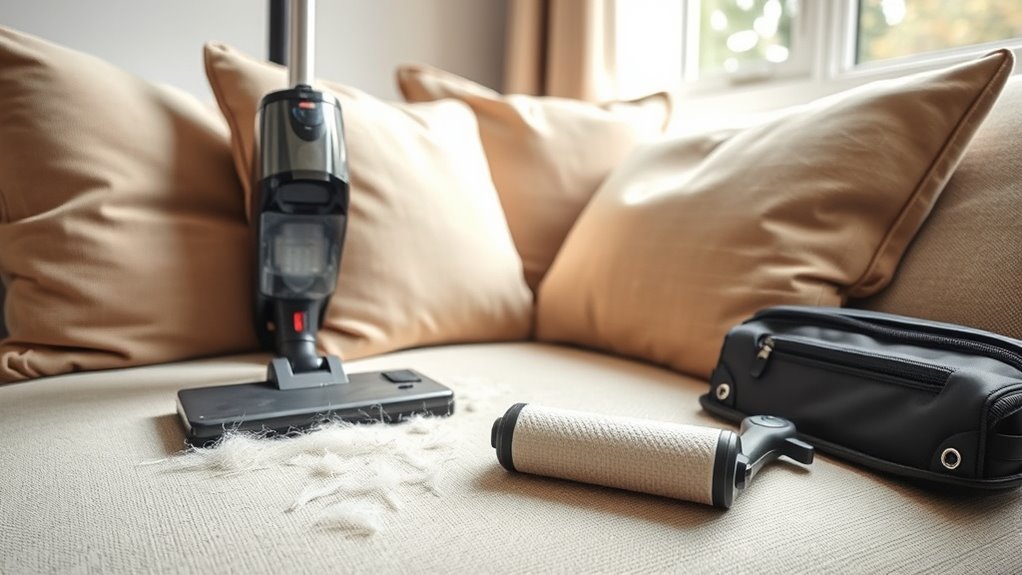To manage pet hair effectively, regularly groom your pets with the right brushes and combs, and keep up a consistent cleaning routine using lint rollers, vacuum cleaners, and damp cloths. Choose pet-friendly, hair-resistant fabrics for furniture and bedding, and use barriers or slipcovers to protect surfaces. Maintaining your pets’ health and hydration also helps reduce shedding. For more tips on keeping your home Fur-free, discover simple strategies that make cleanup easier.
Key Takeaways
- Establish a regular grooming routine using appropriate brushes to minimize shedding and keep your pet’s coat healthy.
- Use pet hair-resistant fabrics like microfiber or leather for furniture and bedding to reduce hair buildup.
- Utilize lint rollers, sticky sheets, or rubber gloves to quickly remove pet hair from surfaces and clothing.
- Cover furniture and beds with washable slipcovers or blankets to trap hair and simplify cleaning.
- Maintain a consistent cleaning schedule with vacuuming and washing to control pet hair spread and keep your home tidy.
Choose the Right Brushes and Combs
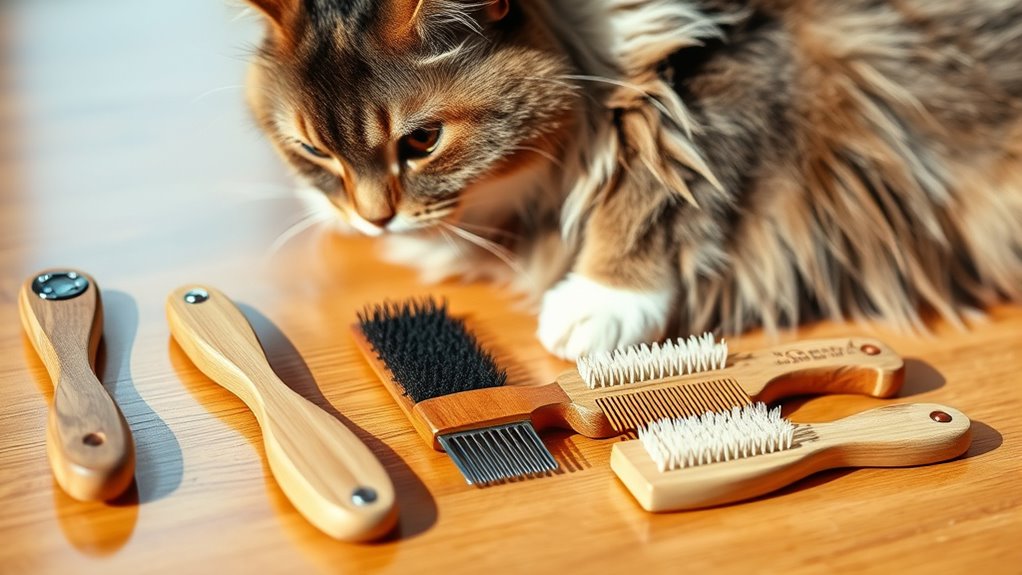
Choosing the right brushes and combs is essential for effectively managing pet hair. Your selection of brushing tools directly impacts your pet’s comfort and the quality of pet grooming. Different breeds require specific types of brushes—slicker brushes work well for thick fur, while bristle brushes suit short-haired pets. Wide-tooth combs help detangle without causing discomfort, especially for long-haired animals. Using the appropriate tools ensures you remove loose hair, dirt, and tangles efficiently, reducing shedding around your home. Proper pet grooming with suitable brushes and combs not only keeps your pet looking good but also promotes healthy skin and fur. Selecting the correct pet grooming tools can significantly improve your grooming routine. Choosing wisely makes grooming easier, less stressful, and more effective. To maximize their benefits, understanding grooming techniques can help you use these tools more effectively.
Establish a Regular Grooming Routine
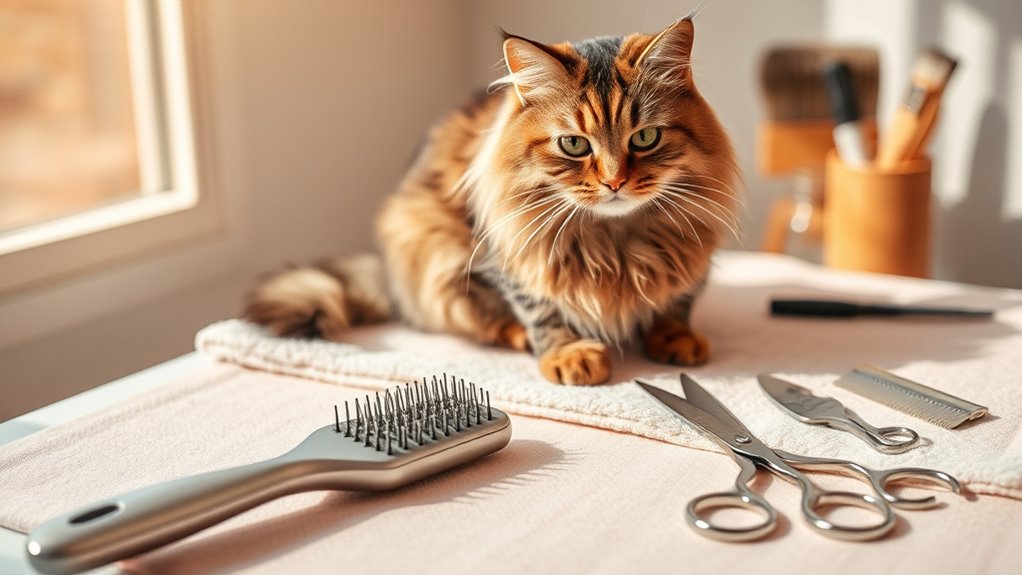
Once you’ve selected the right brushes and combs, the next step is to set up a consistent grooming schedule. Establishing a regular grooming routine helps manage pet hair shedding and keeps your home cleaner. How often you groom depends on your pet’s breed, coat type, and shedding level, but most animals benefit from brushing at least a few times a week. Consistent grooming reduces loose hair and prevents matting, making shedding less overwhelming. Regular grooming sessions also support digital literacy programs that help pet owners learn effective techniques, resulting in healthier coats. By sticking to a routine, you’ll also detect skin issues early and keep your pet comfortable. Additionally, understanding Gold IRA regulations can help you plan for possible future financial needs related to pet care. Cultivating this grooming discipline not only benefits your pet’s health but also fosters a stronger bond between you and your pet. Remember, the key is consistency—grooming frequency should match your pet’s needs to effectively control pet hair shedding and maintain a healthier, happier pet.
Use Lint Rollers and Sticky Sheets Effectively
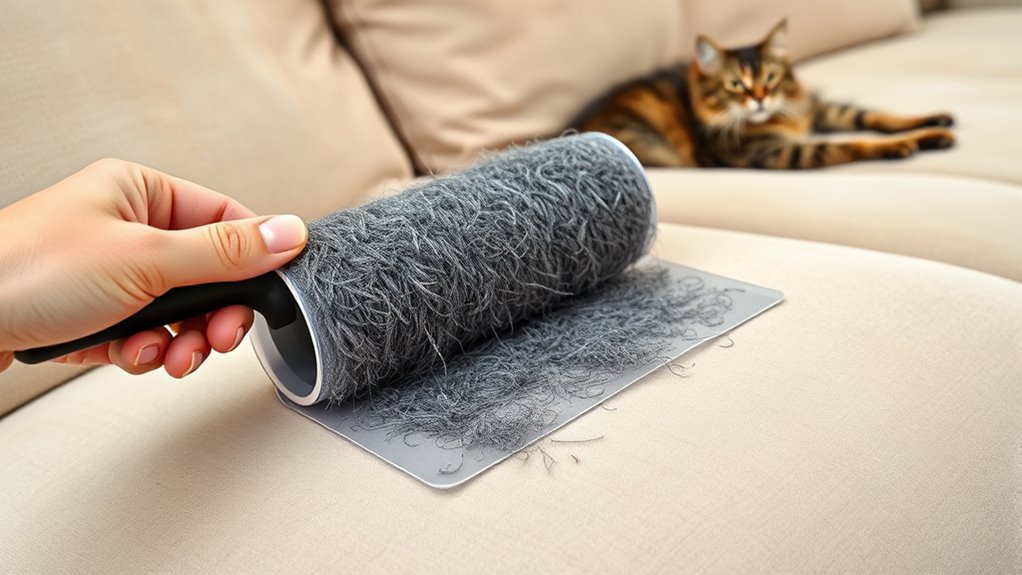
To get the most out of your lint rollers, use firm pressure and go over the same area multiple times to lift stubborn pet hair. Make certain to select sticky sheets designed for heavy pet hair, as they will pick up more effectively and last longer. Switching out sheets regularly ensures your tools stay sticky and work efficiently.
Maximize Lint Roller Usage
Maximizing the effectiveness of lint rollers and sticky sheets starts with using them correctly. To get the most pet hair off your clothes and furniture, focus on proper lint roller techniques and sheet selection. First, make certain you press firmly and roll in one direction to lift hair effectively. Second, change sheets frequently to maintain stickiness, especially after covering large areas. Third, choose sheets with a strong adhesive that suits your needs, whether for delicate fabrics or heavy pet hair. Fourth, using a high-quality vacuum can help remove pet hair from larger surfaces more efficiently before using a lint roller. Additionally, selecting appropriate adhesive strength based on the type of pet hair and fabric can significantly improve results. Understanding AI-powered cleaning tools can further streamline pet hair removal efforts by offering more efficient solutions. Incorporating advanced cleaning technology can enhance your overall pet hair management strategy. By mastering these simple steps, you’ll prevent hair from smudging or spreading. Remember, consistent use and selecting the right sheets help you save time and keep your belongings hair-free. With these tips, pet hair management becomes quick and effortless.
Choose the Right Sheets
Choosing the right sheets for your lint roller or sticky pad is essential to effectively remove pet hair without damaging your fabrics. Opt for sheets with a suitable fabric softness—softer sheets tend to glide smoothly over delicate surfaces, reducing the risk of snags. Consider the thread count; higher thread count sheets often provide a denser surface that traps hair better, while lower thread counts are more flexible and gentle on fabrics. If you’re working on upholstery or bedding, choose sheets designed for heavy-duty use, as they’ll hold more hair and last longer. For finer fabrics, select thinner, more delicate sheets to prevent tearing. Using the appropriate sheets guarantees pet hair removal is efficient, minimizing damage to your fabrics and keeping your home looking clean. Additionally, utilizing appropriate cleaning tools like lint rollers equipped with self-cleaning features can further streamline the process and improve results. Incorporating mindfulness techniques during cleaning can help maintain patience and focus, making the task feel less tedious and more manageable. Leveraging knowledge about vacuum cleaner horsepower can also enhance your cleaning effectiveness, especially for stubborn hair. Furthermore, choosing sheets with specialized adhesive qualities can improve hair pickup and reduce residue left on fabrics.
Incorporate Pet Hair-Resistant Fabrics and Textiles
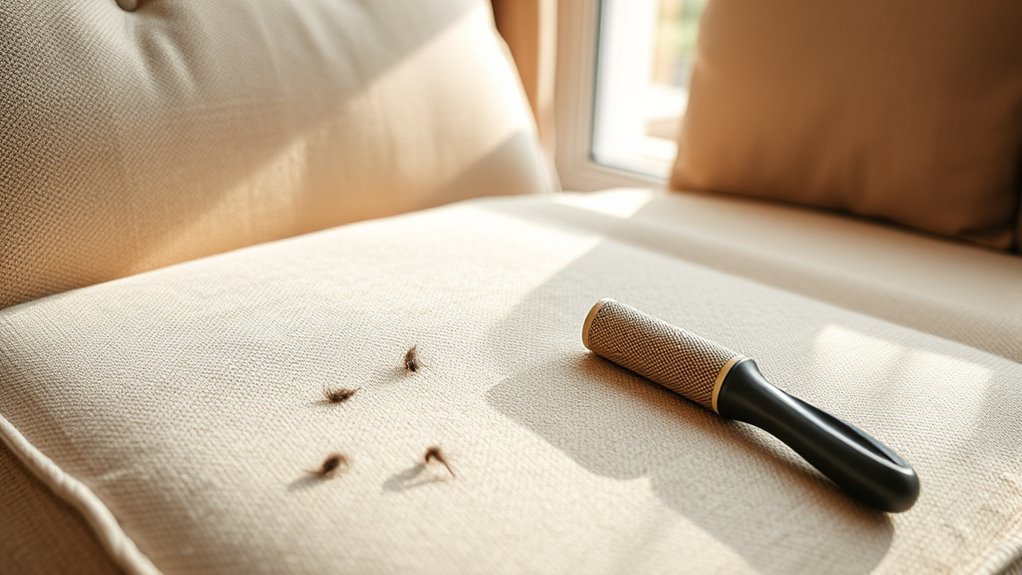
Switching to pet-friendly upholstery and textiles can make a big difference in managing hair. Choose fabrics that resist pet hair and are easy to clean, so maintenance becomes less of a chore. Opting for hair-resistant curtains and durable materials helps keep your home looking tidy with less effort.
Choose Pet-Friendly Upholstery
Since pet hair can quickly accumulate on upholstery, selecting pet-friendly fabrics is essential for easier cleanup. When choosing furniture, prioritize fabric durability and pet-resistant features to minimize maintenance. Consider these options:
- Leather or Faux Leather – Easy to wipe clean and resist pet hair buildup.
- Tightly Woven Fabrics – Such as microfiber or canvas, which trap less hair and are durable.
- Slipcovers or Removable Covers – Allow for quick washing and easy hair removal.
Focusing on furniture selection with these fabrics reduces hair cling and makes cleaning simpler. Durable, pet-friendly upholstery also withstands scratches and wear, saving you money over time. Additionally, pet hair management can be significantly improved by choosing fabrics designed to minimize hair adherence, making your cleaning routine more efficient. By choosing the right textiles, you ensure your furniture stays looking fresh and hair-free longer.
Opt for Hair-Resistant Curtains
Opting for hair-resistant curtains can considerably reduce the hassle of pet hair cleanup around your home. These curtains are made from fabrics specially designed for fabric protection, helping to repel pet hair rather than trapping it. When choosing curtains, look for textiles with tight weaves or treated surfaces that prevent hair from sticking easily. This makes curtain maintenance simpler—you’ll spend less time vacuuming or lint-rolling. Hair-resistant fabrics also help keep your living space looking tidy and fresh. Regularly wipe down the curtains with a damp cloth to maintain their hair-resistant qualities and prolong their lifespan. Additionally, understanding textile art techniques can inspire you to select or even create custom fabrics that enhance your pet-friendly decor. Incorporating pet-friendly textiles can further improve the durability and ease of cleaning for your curtains. Using fabric treatments can enhance the hair-resistant properties of your fabrics, making them last longer and stay cleaner. Employing innovative textile technologies can provide extra protection against pet hair buildup, ensuring your home remains neat and inviting. By selecting these fabrics, you create a pet-friendly environment that’s easier to keep clean and free of pet hair buildup.
Select Durable, Easy-Clean Fabrics
Choosing the right fabrics for your furniture and home decor can make a big difference in managing pet hair. Opt for pet hair-resistant fabrics that combine fabric durability with stain resistance, making cleanup easier. When selecting textiles, consider these options:
- Microfiber – Its tight weave resists pet hair and is easy to vacuum.
- Leather or Faux Leather – Durable and naturally resistant to pet hair and stains.
- Performance Fabrics – Treated for stain resistance and designed to withstand frequent cleaning.
Additionally, selecting fabrics with easy-clean properties can further simplify pet hair maintenance. These fabrics help reduce pet hair buildup and simplify maintenance. Investing in durable, easy-clean textiles guarantees your furniture stays fresh and inviting, even with active pets. Prioritizing stain resistance and fabric durability saves time and effort while keeping your home pet-friendly.
Maintain a Consistent Vacuuming Schedule
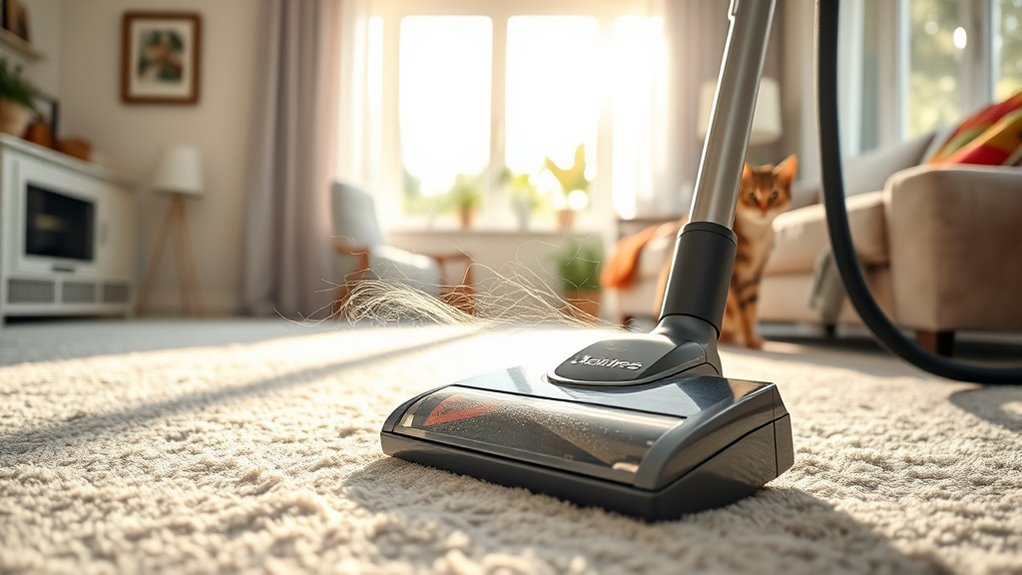
Regular vacuuming is essential for keeping pet hair under control and maintaining a clean home. To do this effectively, establish a consistent cleaning schedule that matches your pet’s shedding habits and your household traffic. The right vacuum frequency depends on how much your pet sheds—more shedding means vacuuming at least three times a week. Sticking to a routine prevents pet hair from building up and becoming harder to remove later. Use a high-quality vacuum designed for pet hair removal, and make sure to cover all surfaces, including carpets, rugs, and upholstery. Additionally, choosing the right vacuum attachments can improve cleaning efficiency on various surfaces. Incorporating scheduled cleaning routines can further streamline the process and ensure no area is overlooked. By maintaining a steady cleaning schedule, you’ll reduce pet hair accumulation, improve air quality, and keep your home looking tidy and fresh. Consistency is key to successful pet hair management.
Utilize Rubber Gloves or Damp Cloths for Quick Cleaning
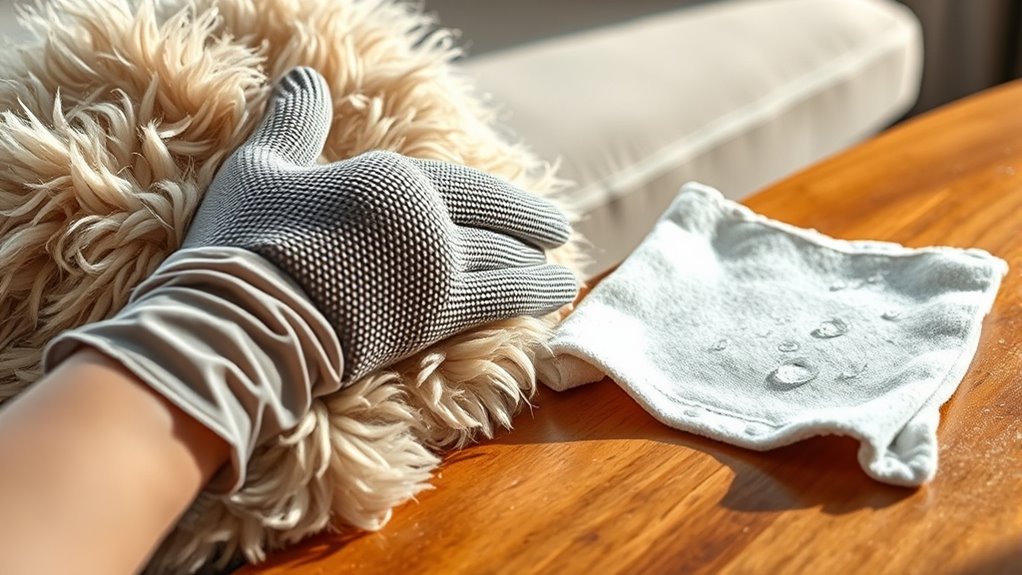
Rubber gloves are great for quickly picking up pet hair from furniture and clothing, thanks to their textured surface. Damp cloths also work well to lift hair from carpets and surfaces with minimal effort. Both tools offer an easy cleanup method, saving you time and keeping your space tidy. Incorporating vacuum cleaner attachments can help prevent pet hair from settling into your hair during grooming or handling. Using tools with high efficiency can further enhance your cleaning effectiveness and reduce residual hair. Additionally, choosing tools with proper design can make the cleaning process even more efficient and comfortable.
Rubber Gloves Effectiveness
When it comes to quickly removing pet hair from surfaces, rubber gloves and damp cloths can be surprisingly effective tools. Rubber gloves effectiveness for pet hair removal is well-known because the textured surface helps lift hair easily. To maximize results, try these tips:
- Wear the gloves and dampen them slightly for better grip.
- Lightly rub or sweep your hand over fabric or furniture.
- Rinse the gloves when they become covered in pet hair, then continue cleaning.
The static created by the gloves attracts pet hair, making cleanup faster and less frustrating. This simple method is especially useful on upholstery, clothing, and carpets. Overall, rubber gloves are a quick, affordable solution for effective pet hair removal.
Damp Cloth Advantages
Damp cloths offer a simple yet effective way to pick up pet hair quickly. The damp cloth advantages lie in its ability to attract hair through cleaning with moisture, making hair removal faster and easier. When you use a damp cloth, the moisture helps lift pet hair from surfaces without spreading it around. It’s especially useful on upholstery, countertops, and wooden furniture, where dry cloths might push hair further into fibers. Plus, using a damp cloth reduces the need for harsh chemicals, making your cleaning routine safer for your home and pets. For best results, guarantee the cloth is just slightly damp—not soaking—so it glides smoothly without dripping. This method saves time, minimizes airborne hair, and keeps your space tidy with minimal effort.
Easy Cleanup Techniques
Using rubber gloves or damp cloths makes pet hair cleanup quick and effortless. These tools are effective for pet hair removal and help prevent allergies by reducing airborne allergens. To maximize their effectiveness:
- Wear rubber gloves and run your hands over furniture and clothing; pet hair sticks to the gloves, making removal simple.
- Use a damp cloth on hard surfaces like tables and countertops to lift pet hair without spreading it around.
- For upholstery, dampen a cloth slightly and wipe in a sweeping motion to gather hair without damaging fabrics.
These techniques allow you to clean quickly, minimize pet hair buildup, and prevent allergy symptoms by removing hair before it becomes airborne. Keep tools handy for fast, efficient pet hair removal anytime.
Create a Dedicated Pet Hair Removal Station

Creating a dedicated pet hair removal station makes it easier to keep your home tidy and your pet comfortable. Choose a convenient spot near the litter box placement to streamline cleanup and minimize mess spread. Keep pet hair storage containers nearby for collected hair, ensuring everything stays organized and accessible. Use a small table or shelf to hold lint rollers, brushes, and vacuum accessories. Having a designated station reduces clutter and encourages regular maintenance, making pet hair management less overwhelming. Label containers for easy identification, and include a trash bin for disposal. By establishing this station, you’ll simplify hair removal routines and maintain a cleaner, more comfortable environment for both you and your pet.
Implement Pet Hair Barriers on Furniture and Bedding
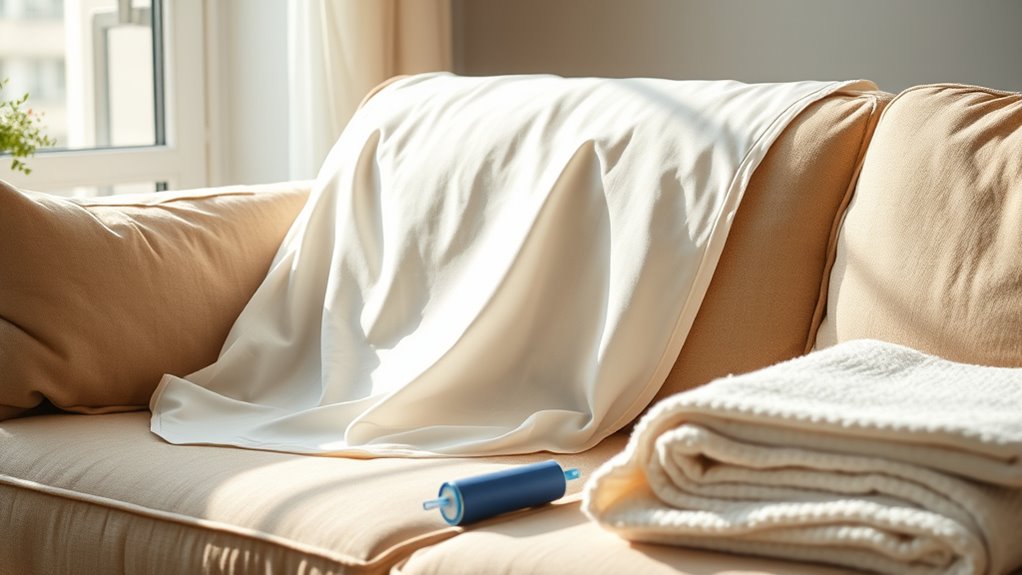
To keep pet hair off your furniture and bedding, implementing effective barriers can make a noticeable difference. Using furniture covers and bedding barriers creates a physical shield that traps hair before it spreads.
Implement furniture covers and bedding barriers to trap pet hair and keep your home cleaner.
Here are three ways to do this:
- Use washable furniture covers on sofas and chairs to easily remove pet hair and protect your upholstery.
- Place bedding barriers, like fitted sheets or pet-specific blankets, over beds and pet sleeping areas to catch hair at the source.
- Opt for slipcovers that are easy to clean, allowing you to quickly remove and wash away accumulated pet hair.
These barriers reduce hair buildup on your furniture and bedding, making cleanup simpler and keeping your home cleaner.
Keep Pets Well-Hydrated and Healthy
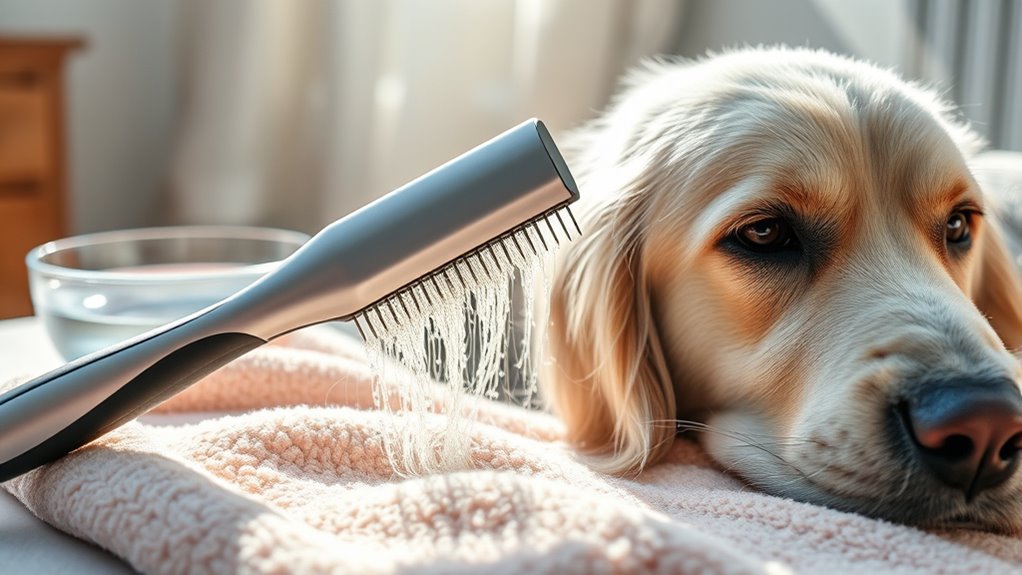
Keeping your pets well-hydrated and healthy is essential for controlling pet hair and maintaining their overall well-being. Proper hydration importance helps prevent dry skin and shedding issues, making grooming easier. Guarantee your pet always has fresh water available and encourage regular drinking. Good pet health tips also include balanced diets and routine vet visits. When pets are healthy, they shed less and produce fewer loose hairs around your home. To make it more engaging:
| Hydration Tips | Health Tips |
|---|---|
| Fresh water daily | Regular vet check-ups |
| Add water to food | Balanced diet |
| Use pet fountains | Exercise regularly |
| Keep bowls clean | Monitor for health issues |
Prioritizing hydration and health keeps your pet comfortable and minimizes pet hair everywhere.
Adopt Additional Home Cleaning Tools and Accessories
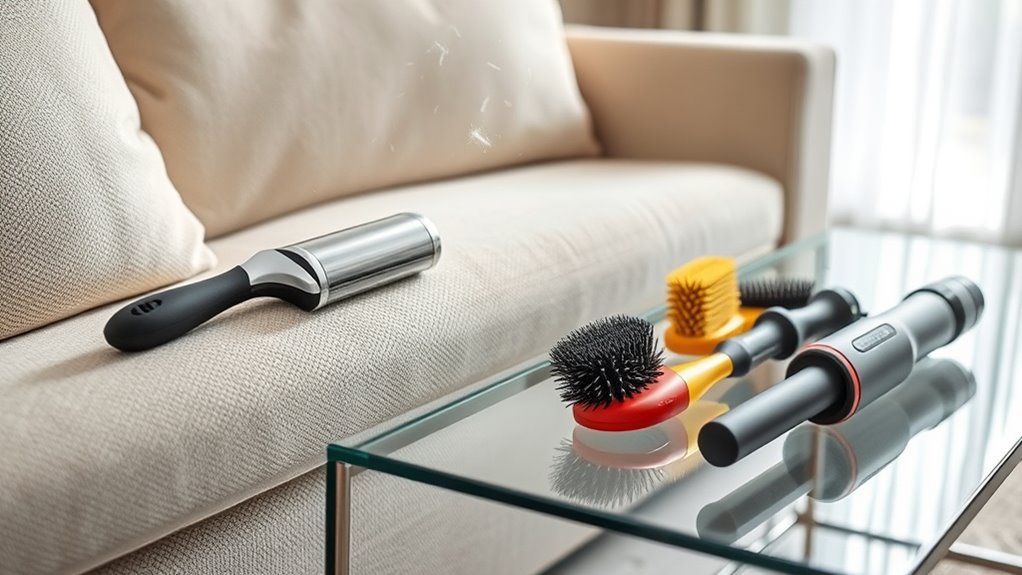
Adding the right cleaning tools and accessories can make managing pet hair much easier. Investing in effective equipment helps you tackle hair buildup quickly and efficiently. Consider these options:
- Vacuum attachment options: Use versatile tools like crevice or upholstery attachments to reach tight spots and furniture.
- Pet hair trapping tools: Equip your vacuum with specialized brushes or rollers designed to lift and trap pet hair from carpets and upholstery.
- Handheld vacuum cleaners: Keep a lightweight, portable vacuum handy for quick clean-ups on furniture, stairs, or car interiors.
These tools work together to reduce pet hair around your home, making cleaning less of a chore and keeping your space looking fresh. With the right accessories, pet hair management becomes much simpler.
Frequently Asked Questions
How Can I Prevent Pet Hair From Spreading to My Clothes?
To prevent pet hair from spreading to your clothes, choose clothing fabrics like tightly woven cotton or synthetic fibers that resist hair cling. Incorporate pet grooming routines, such as regular brushing, to reduce loose hair. Keep a lint roller or sticky tape nearby to quickly remove stray hairs. Wearing a designated outer layer or jacket when around your pet can also help keep hair off your everyday clothes, making laundry easier.
Are There Natural Remedies to Reduce Pet Shedding?
They say, “An ounce of prevention is worth a pound of cure,” and that’s true for pet shedding too. You can try DIY remedies and herbal solutions like adding omega-3 supplements or using natural sprays to reduce shedding. Regular grooming with natural brushes, combined with these herbal remedies, helps strengthen your pet’s coat and minimizes hair loss. Consistent care keeps hair shedding manageable and your home cleaner.
What Are the Best Air Purifiers for Pet Hair Removal?
When choosing the best air purifier for pet hair removal, look for models with advanced air purifier features like HEPA filters and strong airflow. These features help with pet hair filtration, capturing tiny particles and reducing airborne pet hair. Opt for purifiers with high CADR ratings for better performance. Regularly clean or replace filters to maintain efficiency, ensuring your space stays fresh and free of pet hair buildup.
How Often Should I Replace My Pet Hair Removal Tools?
Think of your pet hair removal tools as loyal allies that need regular care. You should follow a steady replacement schedule, usually every few months, to keep them working like a well-oiled machine. Regular tool maintenance prolongs their life and effectiveness, so check for wear and tear often. When your tools start losing their grip or become clogged, it’s time for a fresh start—replacing them keeps your home hair-free and your efforts efficient.
Can Certain Diets Reduce My Pet’s Shedding Significantly?
You’re wondering if certain diets can reduce your pet’s shedding considerably. Diet impact plays a vital role in shedding reduction because high-quality, omega-3 rich foods promote healthier skin and coats. By feeding your pet a balanced diet with essential nutrients, you can help minimize excess hair loss. Consistent nutrition supports a shiny, less-shedding coat, making grooming easier and your home cleaner.
Conclusion
Keeping pet hair under control can feel overwhelming, but with these tips, you’ll make it manageable. Did you know that households with pets shed up to 100 pounds of fur annually? By choosing the right tools and establishing routines, you can considerably reduce pet hair around your home. Stay consistent, and you’ll create a cleaner, more comfortable space for both you and your furry friends. Your efforts will make a noticeable difference every day.
